Double Network Physical Crosslinked Hydrogel for Healing Skin Wounds: New Formulation Based on Polysaccharides and Zn2+
Abstract
:1. Introduction
2. Results and Discussion
2.1. Design Strategy for SA/CS/Zn2+ PDH
2.2. Chemical Structure and Property Analysis
2.2.1. Surface Appearance
2.2.2. FTIR Analysis
2.2.3. Thermal Stability of Hydrogels
2.2.4. Swelling Behavior of Hydrogels
2.2.5. Water Retention Property
2.3. Mechanical Strength and Rheology
2.4. In Vitro Activity of Hydrogels
2.4.1. In Vitro Release of Zn2+
2.4.2. Antioxidant Activity of Hydrogels In Vitro
2.4.3. Antimicrobial Property of Hydrogels
2.5. In Vitro Evaluation of Cytocompatibility
2.6. In Vivo Activity Evaluation
2.6.1. In Vivo Wound Healing in a Total Skin Defect Model
2.6.2. Histological Evaluation of Regenerated Tissue
3. Materials and Methods
3.1. Experimental Materials
3.2. Preparation Method of SA/CS/Zn2+ PDH
3.3. Gelation Time
3.4. Physio-Chemical Properties of SA/CS/Zn2+ PDH
3.5. Swelling Property
3.6. Water Retention Capacity
3.7. Mechanical Performance Testing
3.8. In Vitro Release of Zn2+
3.9. Antioxidant Activity of SA/CS/Zn2+ PDH In Vitro
3.10. In Vitro Evaluation of Antibacterial Properties
3.11. Biocompatibility Testing
3.12. In Vivo Wound Healing Test
3.13. Statistical Analysis
4. Conclusions
Supplementary Materials
Author Contributions
Funding
Institutional Review Board Statement
Informed Consent Statement
Data Availability Statement
Conflicts of Interest
References
- Moon, S.H.; Kaufmann, Y. Enzymatically-crosslinked gelatin hydrogels containing paenipeptin and clarithromycin against carbapenem-resistant pathogen in murine skin wound infection. BMC Microbiol. 2021, 21, 326. [Google Scholar] [CrossRef]
- Ahmadian, Z.; Gheybi, H. Efficient wound healing by antibacterial property: Advances and trends of hydrogels, hydrogel-metal NP composites and photothermal therapy platforms. J. Drug Deliv. Sci. Technol. 2022, 73, 103458. [Google Scholar] [CrossRef]
- Meng, X.; Lu, Y. Chitosan/alginate/hyaluronic acid polyelectrolyte composite sponges crosslinked with genipin for wound dressing application. Int. J. Biol. Macromol. 2021, 182, 512–523. [Google Scholar] [CrossRef]
- Ye, S.; Jiang, L. Development of gelatin/bacterial cellulose composite sponges as potential natural wound dressings. Int. J. Biol. Macromol. 2019, 133, 148–155. [Google Scholar] [CrossRef]
- Pacheco, M.S.; Kano, G.E. Silk fibroin/chitosan/alginate multilayer membranes as a system for controlled drug release in wound healing. Int. J. Biol. Macromol. 2020, 152, 803–811. [Google Scholar] [CrossRef]
- Chelminiak-Dudkiewicz, D.; Smolarkiewicz-Wyczachowski, A. Chitosan-based films with cannabis oil as a base material for wound dressing application. Sci. Rep. 2022, 12, 18658. [Google Scholar] [CrossRef]
- Carpa, R.; Farkas, A. Double-Network Chitosan-Based Hydrogels with Improved Mechanical, Conductive, Antimicrobial, and Antibiofouling Properties. Gels 2023, 9, 278. [Google Scholar] [CrossRef]
- Aziz, M.S.A.; Salama, H.E. Biocompatible and antimicrobial carboxymethyl xanthan/zinc physical hydrogels. Polym. Bull. 2022, 79, 3219–3231. [Google Scholar] [CrossRef]
- Zheng, Q.F.; Zhao, L.Y. High-strength and high-toughness sodium alginate/polyacrylamide double physically crosslinked network hydrogel with superior self-healing and self-recovery properties prepared by a one-pot method. Colloids Surf. A-Physicochem. Eng. Asp. 2020, 589, 124402. [Google Scholar] [CrossRef]
- Das Mahapatra, R.; Imani, K.B.C. Integration of Macro-Cross-Linker and Metal Coordination: A Super Stretchable Hydrogel with High Toughness. ACS Appl. Mater. Interfaces 2020, 12, 40786–40793. [Google Scholar] [CrossRef] [PubMed]
- Zhao, J.; Xing, T. Preparation of chitosan and carboxymethylcellulose-based polyelectrolyte complex hydrogel via SD-A-SGT method and its adsorption of anionic and cationic dye. J. Appl. Polym. Sci. 2020, 137, e48980. [Google Scholar] [CrossRef]
- Kim, J.; Kim, Y. A pH-sensitive drug delivery using biodegradable succinoglycan/chitosan hydrogels with synergistic antibacterial activity. Int. J. Biol. Macromol. 2023, 242, 124888. [Google Scholar] [CrossRef] [PubMed]
- Kouser, S.; Prabhu, A. Poly (caprolactone)/sodium-alginate-functionalized halloysite clay nanotube nanocomposites: Potent biocompatible materials for wound healing applications. Int. J. Pharm. 2021, 607, 121048. [Google Scholar] [CrossRef] [PubMed]
- Afraz, S.; Ghasemzadeh, H. Nanomagnetic hydrogel based on chitosan, hyaluronic acid, and glucose oxidase as a nanotheranostic platform for simultaneous therapeutic and imaging applications. Mater. Today Chem. 2022, 24, 100807. [Google Scholar] [CrossRef]
- Blackstone, B.N.; Hahn, J.M. Inflammatory response and biomechanical properties of coaxial scaffolds for engineered skin in vitro and post-grafting. Acta Biomater. 2018, 80, 247–257. [Google Scholar] [CrossRef]
- Makarova, A.O.; Derkach, S.R. Ion-Induced Polysaccharide Gelation: Peculiarities of Alginate Egg-Box Association with Different Divalent Cations. Polymers 2023, 15, 1243. [Google Scholar] [CrossRef]
- Colobatiu, L.; Gavan, A. Evaluation of bioactive compounds-loaded chitosan films as a novel and potential diabetic wound dressing material. React. Funct. Polym. 2019, 145, 104369. [Google Scholar] [CrossRef]
- Mukherjee, D.; Azamthulla, M. Development and characterization of chitosan-based hydrogels as wound dressing materials. J. Drug Deliv. Sci. Technol. 2018, 46, 498–510. [Google Scholar] [CrossRef]
- Ghazzy, A.; Naik, R.R. Metal-Polymer Nanocomposites: A Promising Approach to Antibacterial Materials. Polymers 2023, 15, 2167. [Google Scholar] [CrossRef]
- Venditti, L.; Barbero, N. Electrodeposited ZnO with squaraine sentisizers as photoactive anode of DSCs. Mater. Res. Express 2014, 1, 015040. [Google Scholar] [CrossRef]
- Qiu, M.J.; Sun, P. Chaotropic Polymer Additive with Ion Transport Tunnel Enable Dendrite-Free Zinc Battery. ACS Appl. Mater. Interfaces 2022, 14, 40951–40958. [Google Scholar] [CrossRef] [PubMed]
- Mao, T.; Liu, M.C. A Study on Doping and Compound of Zinc Oxide Photocatalysts. Polymers 2022, 14, 4484. [Google Scholar] [CrossRef] [PubMed]
- Venditti, I. Morphologies and functionalities of polymeric nanocarriers as chemical tools for drug delivery: A review. J. King Saud Univ. Sci. 2019, 31, 398–411. [Google Scholar] [CrossRef]
- Luong, D.; Yergeshov, A.A. Transition metal-doped cryogels as bioactive materials for wound healing applications. Mater. Sci. Eng. C-Mater. Biol. Appl. 2019, 103, 109759. [Google Scholar] [CrossRef]
- Chaturvedi, A.; Bajpai, A.K. Evaluation of poly (vinyl alcohol) based cryogel-zinc oxide nanocomposites for possible applications as wound dressing materials. Mater. Sci. Eng. C-Mater. Biol. Appl. 2016, 65, 408–418. [Google Scholar] [CrossRef] [PubMed]
- Diniz, F.R.; Maia, R. Silver Nanoparticles-Composing Alginate/Gelatine Hydrogel Improves Wound Healing In Vivo. Nanomaterials 2020, 10, 390. [Google Scholar] [CrossRef] [PubMed]
- Kumar, A.; Rao, K.M. Synthesis of mechanically stiff and bioactive hybrid hydrogels for bone tissue engineering applications. Chem. Eng. J. 2017, 317, 119–131. [Google Scholar] [CrossRef]
- Fernandes, R.D.; Tanaka, F.N. Development of alginate/starch-based hydrogels crosslinked with different ions: Hydrophilic, kinetic and spectroscopic properties. Mater. Today Commun. 2019, 21, 100636. [Google Scholar] [CrossRef]
- Kumar, A.; Sah, D.K. A calcium and zinc composite alginate hydrogel for pre-hospital hemostasis and wound care. Carbohydr. Polym. 2023, 299, 120186. [Google Scholar] [CrossRef]
- Field, F.K.; Kerstein, M.D. Overview of wound healing in a moist environment. Am. J. Surg. 1994, 167, 2S–6S. [Google Scholar] [CrossRef]
- Khodaei, T.; Nourmohammadi, J. An antibacterial and self-healing hydrogel from aldehyde-carrageenan for wound healing applications. Carbohydr. Polym. 2023, 302, 120371. [Google Scholar] [CrossRef] [PubMed]
- Zhang, M.; Qiao, X.N. Alginate-chitosan oligosaccharide-ZnO composite hydrogel for accelerating wound healing. Carbohydr. Polym. 2021, 266, 118100. [Google Scholar] [CrossRef] [PubMed]
- Yan, Y.S.; Ren, P.P. Precise Design of Alginate Hydrogels Crosslinked with Microgels for Diabetic Wound Healing. Biomolecules 2022, 12, 1582. [Google Scholar] [CrossRef]
- Pino, P.; Bosco, F. Antimicrobial Nano-Zinc Oxide Biocomposites for Wound Healing Applications: A Review. Pharmaceutics 2023, 15, 970. [Google Scholar] [CrossRef] [PubMed]
- Lohana, P.; Suryaprawira, A. Role of Enzymic Antioxidants in Mediating Oxidative Stress and Contrasting Wound Healing Capabilities in Oral Mucosal/Skin Fibroblasts and Tissues. Antioxidants 2023, 12, 1374. [Google Scholar] [CrossRef]
- Hassan, A.; Elebeedy, D. Investigation of Angiogenesis and Wound Healing Potential Mechanisms of Zinc Oxide Nanorods. Front. Pharmacol. 2021, 12, 661217. [Google Scholar] [CrossRef] [PubMed]
- Mutlu, N.; Liverani, L. Zinc improves antibacterial, anti-inflammatory and cell motility activity of chitosan for wound healing applications. Int. J. Biol. Macromol. 2022, 213, 845–857. [Google Scholar] [CrossRef]
- Tomic, S.L.J.; Vukovic, J.S. Antimicrobial Activity of Silver, Copper, and Zinc Ions/Poly(Acrylate/Itaconic Acid) Hydrogel Matrices. Inorganics 2022, 10, 38. [Google Scholar] [CrossRef]
- Sukhodub, L.; Kumeda, M. Metal ions doping effect on the physicochemical, antimicrobial, and wound healing profiles of alginate-based composite. Carbohydr. Polym. 2023, 304, 120486. [Google Scholar] [CrossRef]
- Negi, D.; Singh, Y. Gallium Oxide Nanoparticle-Loaded, Quaternized Chitosan-Oxidized Sodium Alginate Hydrogels for Treatment of Bacteria-Infected Wounds. ACS Appl. Nano Mater. 2023, 6, 13616–13628. [Google Scholar] [CrossRef]
- Ninan, N.; Forget, A. Antibacterial and Anti-Inflammatory pH-Responsive Tannic Acid-Carboxylated Agarose Composite Hydrogels for Wound Healing. ACS Appl. Mater. Interfaces 2016, 8, 28511–28521. [Google Scholar] [CrossRef] [PubMed]
- Moghadam, N.A.; Bagheri, F. Chondroitin sulfate modified chitosan nanoparticles as an efficient and targeted gene delivery vehicle to chondrocytes. Colloids Surf. B—Biointerfaces 2022, 219, 112786. [Google Scholar] [CrossRef] [PubMed]
- Kushibiki, T.; Mayumi, Y. Photocrosslinked gelatin hydrogel improves wound healing and skin flap survival by the sustained release of basic fibroblast growth factor. Sci. Rep. 2021, 11, 23094. [Google Scholar] [CrossRef]
- Plikus, M.V.; Wang, X.J. Fibroblasts: Origins, definitions, and functions in health and disease. Cell 2021, 184, 3852–3872. [Google Scholar] [CrossRef]
- Chang, Z.T.; Chen, Y.J. Construction of chitosan/polyacrylate/graphene oxide composite physical hydrogel by semi-dissolution/acidification/sol-gel transition method and its simultaneous cationic and anionic dye adsorption properties. Carbohydr. Polym. 2020, 229, 115431. [Google Scholar] [CrossRef] [PubMed]
- Musaie, K.; Abbaszadeh, S. Metal-coordination synthesis of a natural injectable photoactive hydrogel with antibacterial and blood-aggregating functions for cancer thermotherapy and mild-heating wound repair. Biomater. Sci. 2023, 11, 2486–2503. [Google Scholar] [CrossRef]
- Zakerikhoob, M.; Abbasi, S. Curcumin-incorporated crosslinked sodium alginate-g-poly (N-isopropyl acrylamide) thermo-responsive hydrogel as an in-situ forming injectable dressing for wound healing: In vitro characterization and in vivo evaluation. Carbohydr. Polym. 2021, 271, 118434. [Google Scholar] [CrossRef]
- Gharekhani, H.; Olad, A. Superabsorbent hydrogel made of NaAlg-g-poly(AA-co-AAm) and rice husk ash: Synthesis, characterization, and swelling kinetic studies. Carbohydr. Polym. 2017, 168, 1–13. [Google Scholar] [CrossRef]
- Krol, Z.; Malik, M. Physicochemical Properties of Biopolymer Hydrogels Treated by Direct Electric Current. Polymers 2016, 8, 248. [Google Scholar] [CrossRef]
- Czaplicka, N.; Mania, S. Influence of Rhamnolipids and Ionic Cross-Linking Conditions on the Mechanical Properties of Alginate Hydrogels as a Model Bacterial Biofilm. Int. J. Mol. Sci. 2021, 22, 6840. [Google Scholar] [CrossRef]
- Geng, Z.J.; Ji, Y.X. Preparation and characterization of a dual cross-linking injectable hydrogel based on sodium alginate and chitosan quaternary ammonium salt. Carbohydr. Res. 2021, 507, 108389. [Google Scholar] [CrossRef]
- Li, Z.; Chen, S.H. Multifunctional Dual Ionic-Covalent Membranes for Wound Healing. ACS Biomater. Sci. Eng. 2020, 6, 6949–6960. [Google Scholar] [CrossRef] [PubMed]
- Mirjalili, F.; Mahmoodi, M. Controlled release of protein from gelatin/chitosan hydrogel containing platelet-rich fibrin encapsulated in chitosan nanoparticles for accelerated wound healing in an animal model. Int. J. Biol. Macromol. 2023, 225, 588–604. [Google Scholar] [CrossRef] [PubMed]
- Itzhakov, R.; Eretz-Kdosha, N. Oligochitosan and oxidized nucleoside-based bioderived hydrogels for wound healing. Carbohydr. Polym. 2023, 314, 120947. [Google Scholar] [CrossRef] [PubMed]
- Yang, F.M.; Chen, L.Q. A novel water-soluble chitosan grafted with nerol: Synthesis, characterization and biological activity. Int. J. Biol. Macromol. 2023, 232, 123498. [Google Scholar] [CrossRef]
- Yang, F.M.; Wang, Z.C. Food-derived Crassostrea gigas peptides self-assembled supramolecules for scarless healing. Compos. Part B—Eng. 2022, 246, 110265. [Google Scholar] [CrossRef]
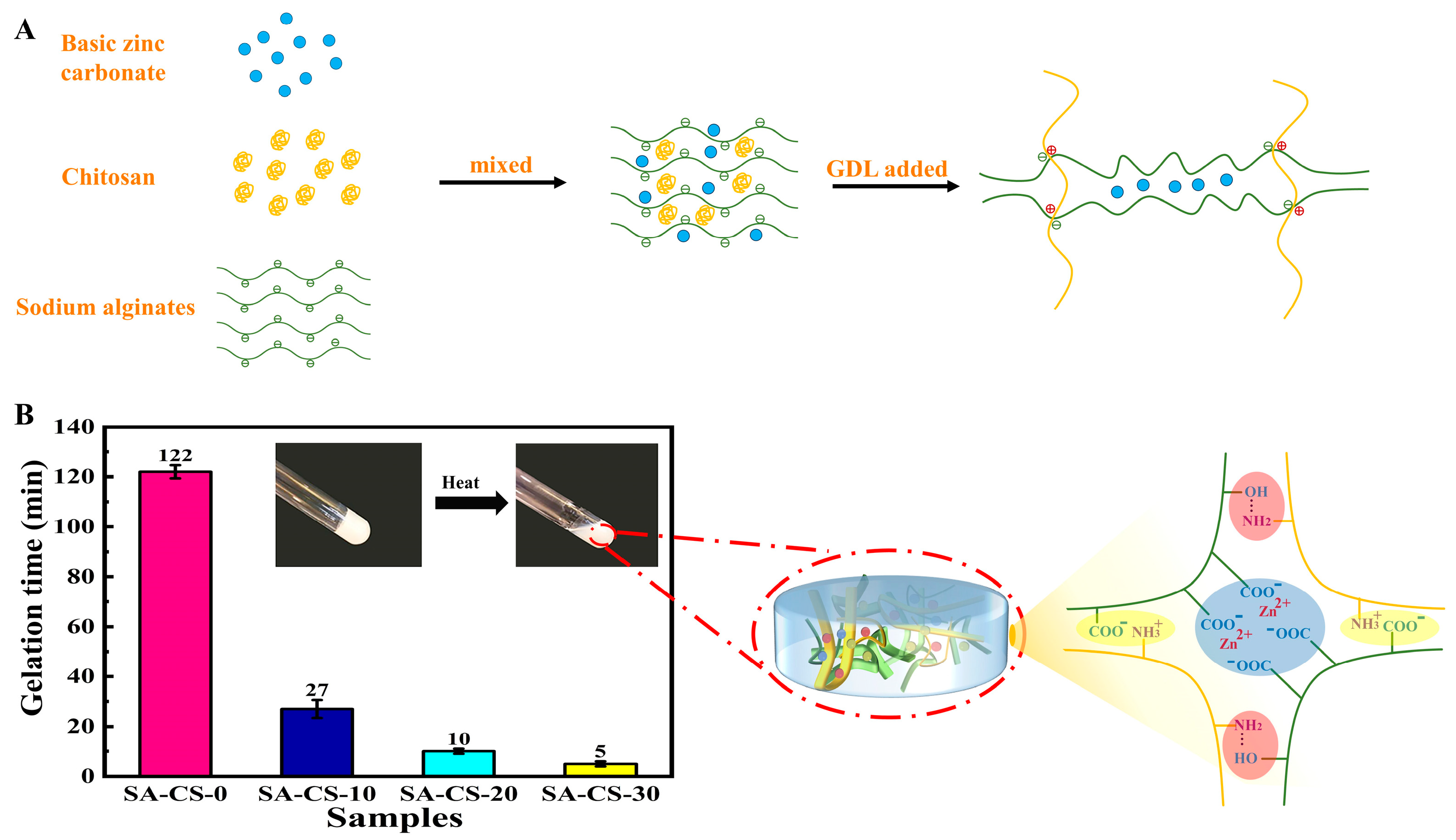

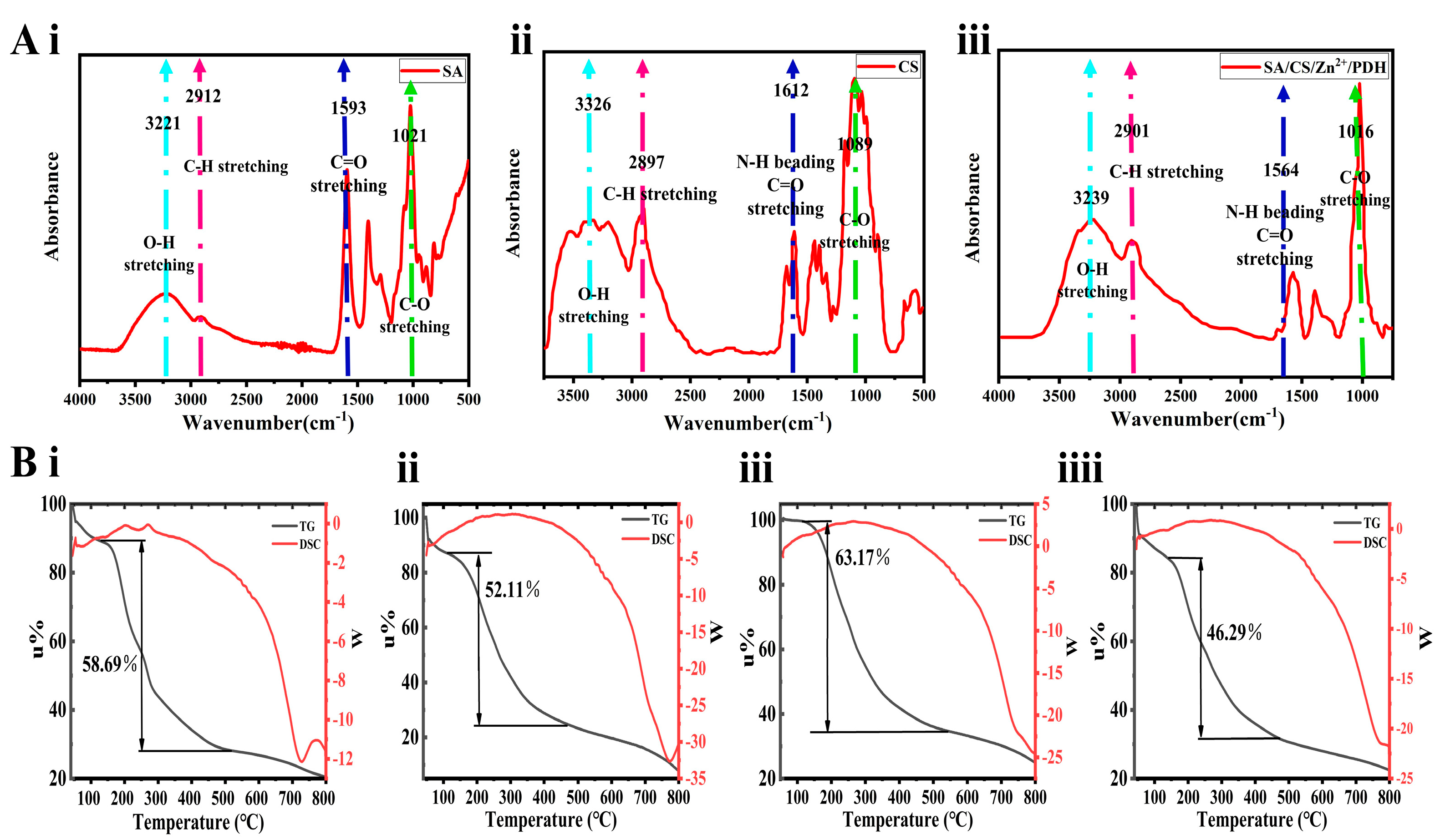
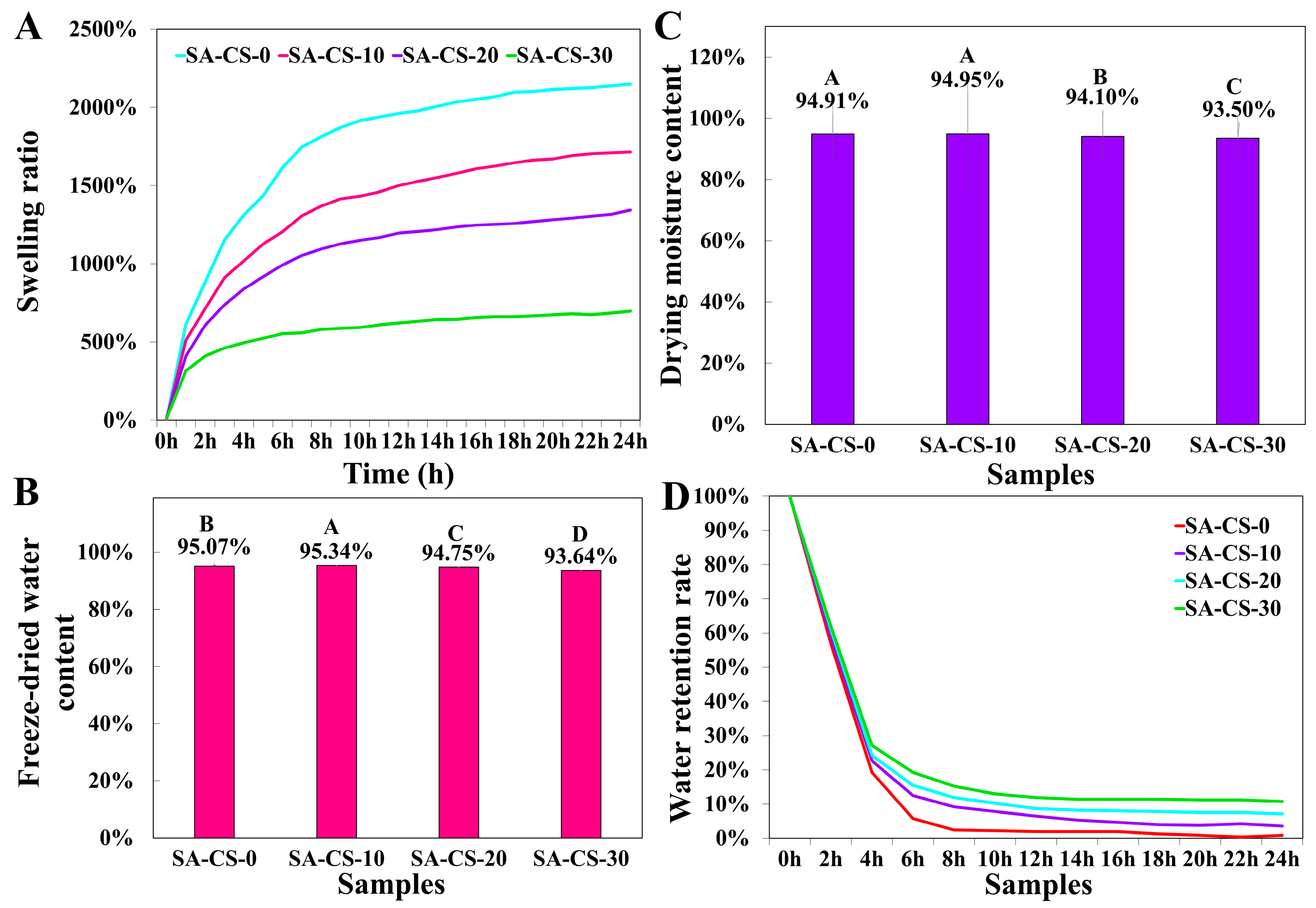

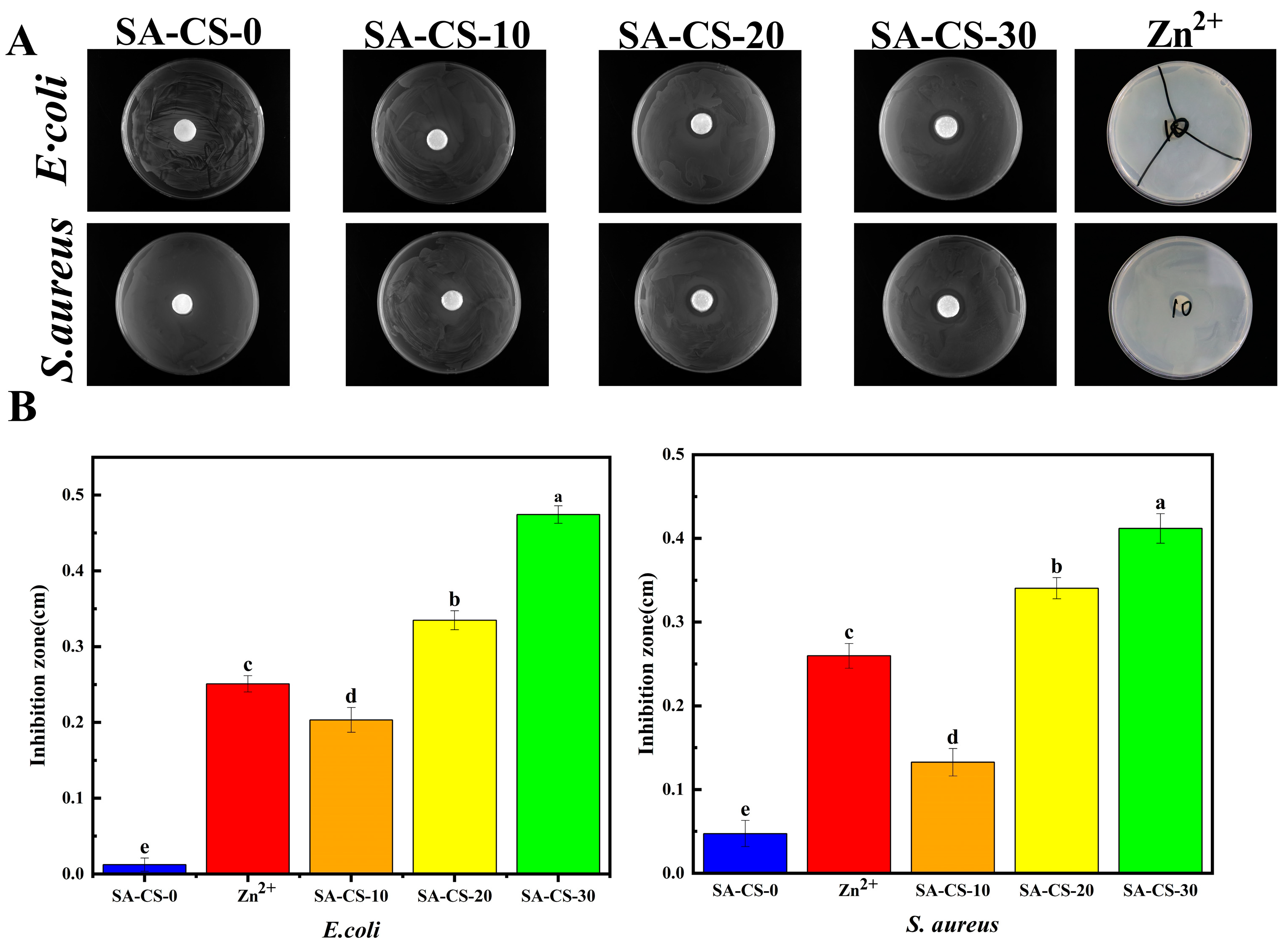
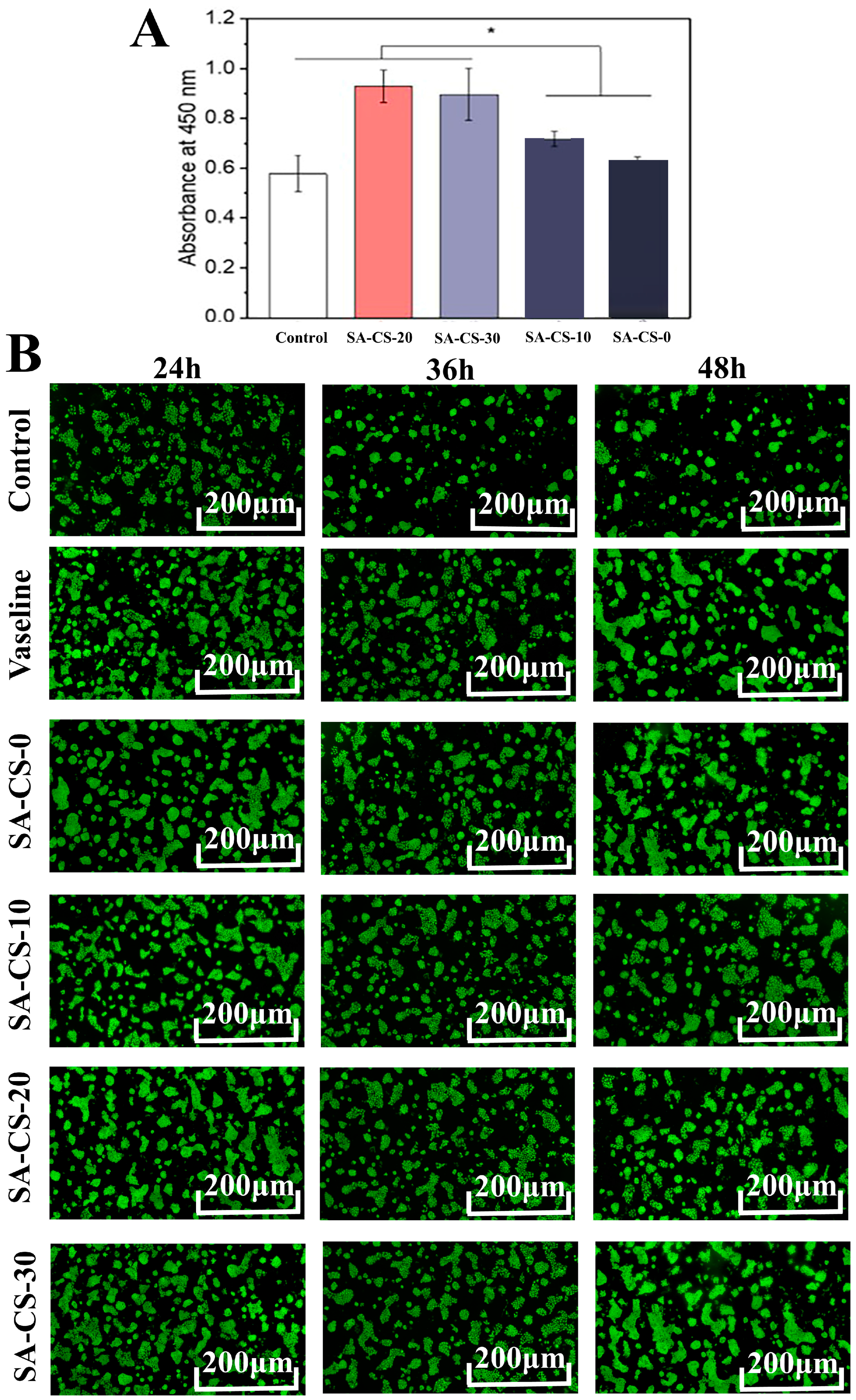
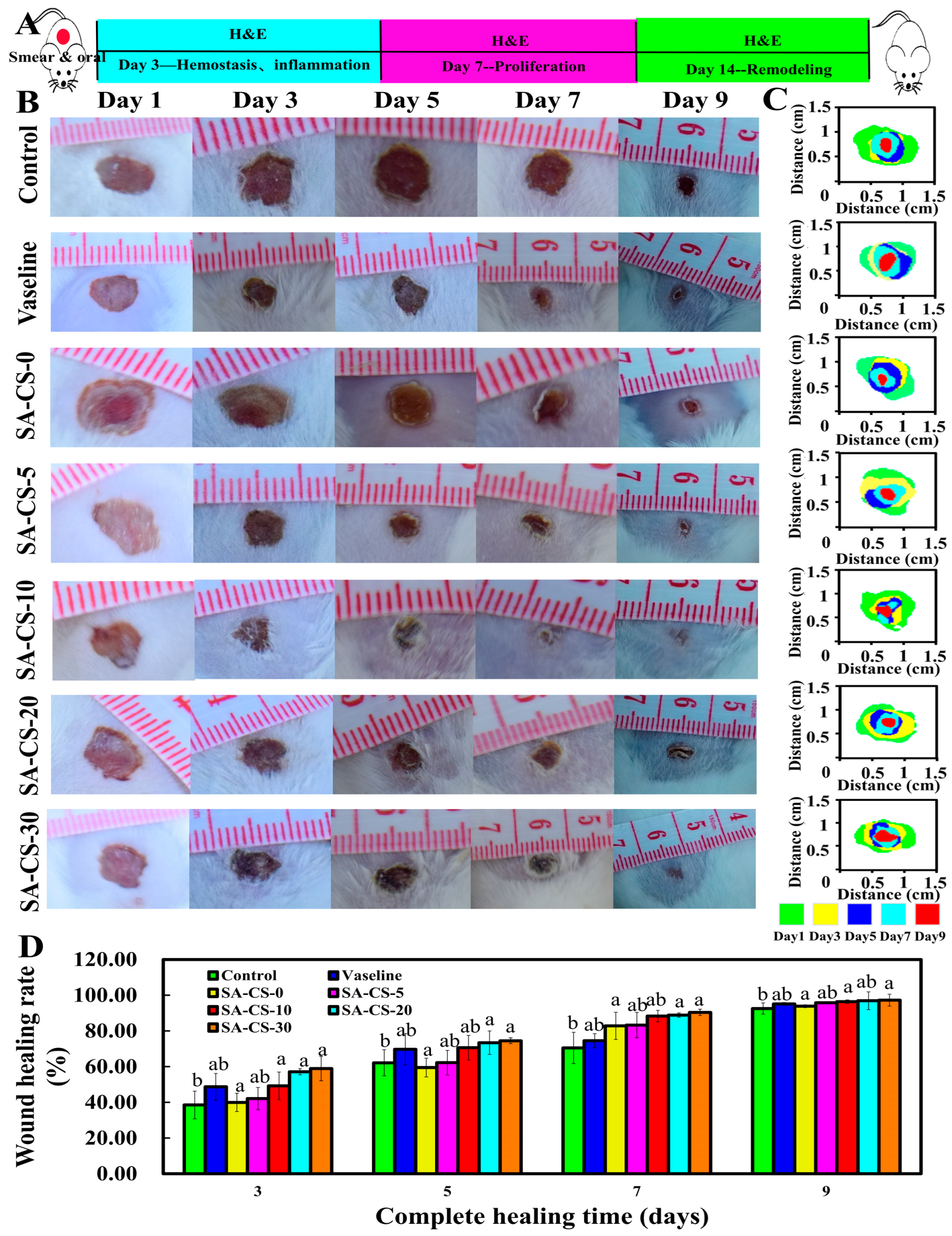
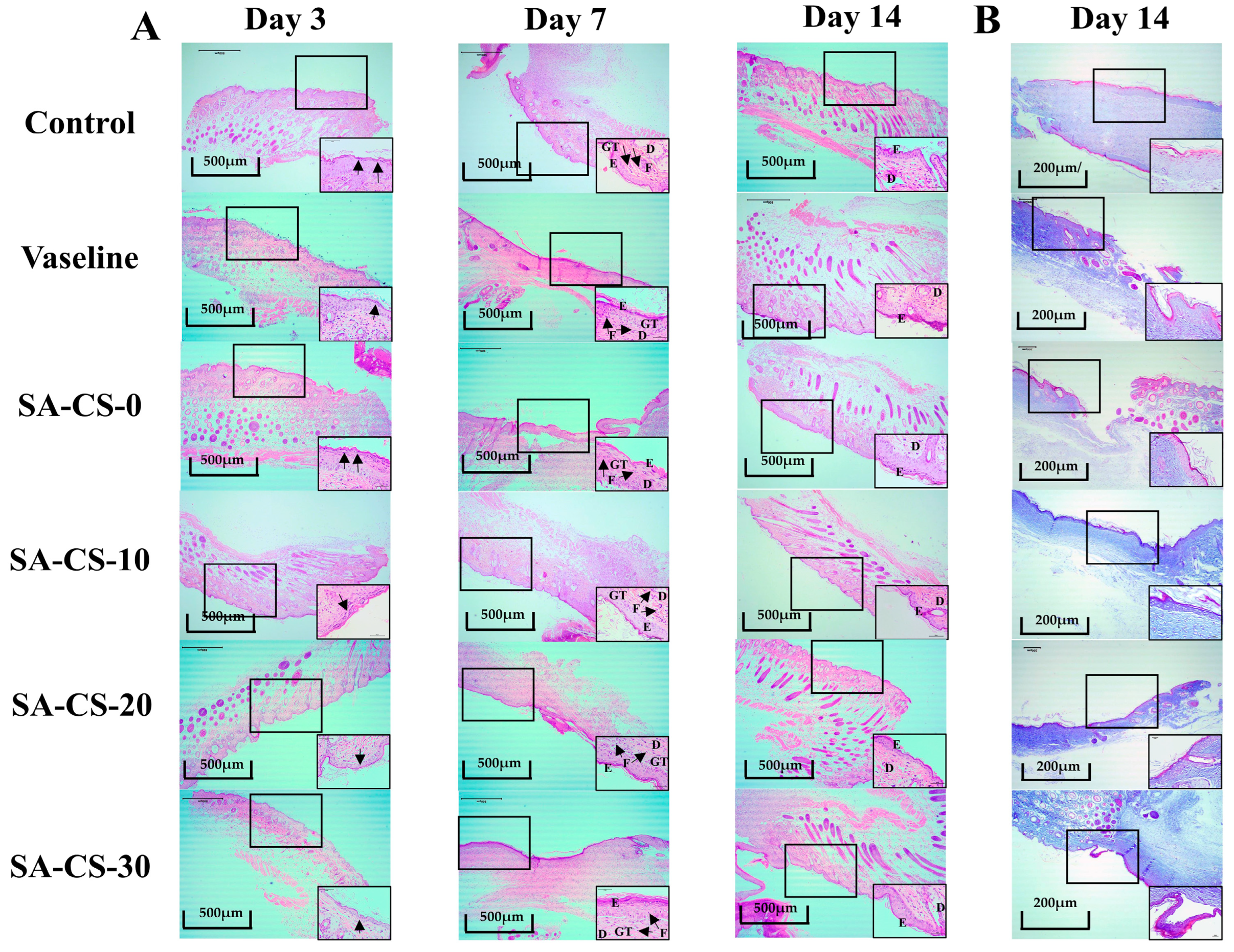
Disclaimer/Publisher’s Note: The statements, opinions and data contained in all publications are solely those of the individual author(s) and contributor(s) and not of MDPI and/or the editor(s). MDPI and/or the editor(s) disclaim responsibility for any injury to people or property resulting from any ideas, methods, instructions or products referred to in the content. |
© 2023 by the authors. Licensee MDPI, Basel, Switzerland. This article is an open access article distributed under the terms and conditions of the Creative Commons Attribution (CC BY) license (https://creativecommons.org/licenses/by/4.0/).
Share and Cite
Cui, S.; Yang, F.; Yu, D.; Shi, C.; Zhao, D.; Chen, L.; Chen, J. Double Network Physical Crosslinked Hydrogel for Healing Skin Wounds: New Formulation Based on Polysaccharides and Zn2+. Int. J. Mol. Sci. 2023, 24, 13042. https://doi.org/10.3390/ijms241713042
Cui S, Yang F, Yu D, Shi C, Zhao D, Chen L, Chen J. Double Network Physical Crosslinked Hydrogel for Healing Skin Wounds: New Formulation Based on Polysaccharides and Zn2+. International Journal of Molecular Sciences. 2023; 24(17):13042. https://doi.org/10.3390/ijms241713042
Chicago/Turabian StyleCui, Shenghao, Faming Yang, Dingyi Yu, Chao Shi, Di Zhao, Liqi Chen, and Jingdi Chen. 2023. "Double Network Physical Crosslinked Hydrogel for Healing Skin Wounds: New Formulation Based on Polysaccharides and Zn2+" International Journal of Molecular Sciences 24, no. 17: 13042. https://doi.org/10.3390/ijms241713042
APA StyleCui, S., Yang, F., Yu, D., Shi, C., Zhao, D., Chen, L., & Chen, J. (2023). Double Network Physical Crosslinked Hydrogel for Healing Skin Wounds: New Formulation Based on Polysaccharides and Zn2+. International Journal of Molecular Sciences, 24(17), 13042. https://doi.org/10.3390/ijms241713042




